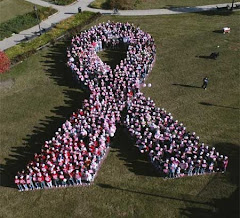When I met with my oncologist this past May and he showed me the CT report describing the growth of my lung tumors, he reminded me that I told him of a technique last year that kills tumors one by one. “Maybe it’s time to pursue that,” he said, just before panic set in. I went through my DVR recordings and found the Discovery Channel special,
Living With Cancer, that I mentioned in my October 26th post. Leroy Sievers had a procedure called a radiofrequency ablation, or
RFA, performed on camera, and that procedure has influenced my cancer status dramatically. There is quite a lot of information about this procedure online (a basic
Google search will bring up volumes), but few patients know about it, and were it not for Leroy, I wouldn’t know about it either.
I researched and found the doctor that performed three ablations on Leroy, and I went to see him. His name is
Dr. Christos Georgiades and he is at Johns Hopkins Hospital in Baltimore. At our consultation, Dr. Georgiades said that he could ablate all 8 of my tumors. My relief was indescribable. Although it may be uncommon to ablate as many as 8 tumors in any one location, he recognized that, because Adenoid Cystic Carcinoma of the Breast (
ACCB) grows so slowly, RFA could be of tremendous benefit to me. The doctor I saw on TV was telling me, basically, that he could save my life – or at least prolong it for a really long time.
There was just one problem. Although most of the lesions were on the periphery of my lungs, one was right next to my aortic arch – the superhighway of my heart. In his interview with Ted Koppel, Dr. Georgiades said, “There are limitations. For example, if a part of a tumor is too close to a critical structure like the heart or a major blood vessel, we may not be able to perform this procedure.” After consulting with thoracic surgeons from two hospitals, I was told, for different reasons, that surgery to remove this tumor was not an option. And since surgeons don’t want to operate if all the cancer can’t be removed, they wished me the best of luck. But Dr. Georgiades saw a way to safely perform the ablation without risking a “catastrophic complication” with the superhighway.
On August 28th, I had my first RFA procedure. Dr. Georgiades ablated the tumor by my aorta and another one in my right lung. This was done under a live CT machine with a needle that carries very high frequency electricity and essentially burns away the tumors along with a small margin of tissue. I was under conscious sedation and I was in no pain. I was sore for a few days, but I was able to return to work quickly with almost no discomfort. It takes several months for the inflammation to recede completely, but I’m confident that this procedure was successful. On November 4th, I returned for a second procedure to kill the two remaining tumors in my right lung. Again, I was feeling almost 100% recovered after a few days, and I can’t even find the marks where the ablations occurred. I’m scheduled for a third RFA, this time on my left lung, on November 18th, after which I will only have two tumors left.
Here is what I learned since pursuing RFA as a treatment option:
Interventional Radiology (IR) is a new field of cancer treatment that offers RFA for tumors in the lungs, liver, bones and kidneys, as long as they are smaller than 3 or 4 cm. This procedure can be a life saving option, especially for patients who cannot have surgery. In addition to RFA, interventional radiology offers a number of minimally invasive techniques that have the potential to change the face of cancer treatment in the next few decades. It’s important to find an interventional radiologist who has done this a lot and knows the techniques well. Often these doctors are not marketed by their hospitals very well, so patients may need to do some research to find them. Some insurance companies may not cover IR techniques because they are still relatively new. But I am lucky that my health insurance covers RFA procedures and that Johns Hopkins accepts my insurance, which is Aetna.
After many tests and scans, I’ve been told that the lung tumors are the only detectable cancer in my body. But eliminating them doesn't eliminate metastatic disease. I still have to figure out how to curtail the metastasis and send it into dormancy. No one really knows how my cancer spreads, so this is a big project. At first I thought it was arrogant to think that I could rein in metastatic disease when my cancer only occurs in a handful of people worldwide. But as I stumbled upon various medical practitioners and scientists who not only offer their expertise, but actually listen to what I have to say and respect my choices, it doesn’t seem so crazy anymore. Dr. Georgiades is one of those people, and I’m very grateful to him and his staff.
Kathy
CANcer + HEALth = CAN HEAL

.bmp)